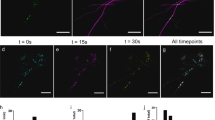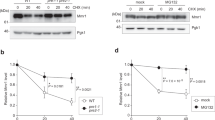Abstract
Normal cellular function requires that organelles be positioned in specific locations. The direction in which molecular motors move organelles is based in part on the polarity of microtubules and actin filaments1,2,3. However, this alone does not determine the intracellular destination of organelles. For example, the yeast class V myosin, Myo2p, moves several organelles to distinct locations during the cell cycle4,5,6,7,8. Thus the movement of each type of Myo2p cargo must be regulated uniquely. Here we report a regulatory mechanism that specifically provides directionality to vacuole movement. The vacuole-specific Myo2p receptor, Vac17p, has a key function in this process. Vac17p binds simultaneously to Myo2p and to Vac8p, a vacuolar membrane protein. The transport complex, Myo2p–Vac17p–Vac8p, moves the vacuole to the bud, and is then disrupted through the degradation of Vac17p. The vacuole is ultimately deposited near the centre of the bud. Removal of a PEST sequence (a potential signal for rapid protein degradation) within Vac17p causes its stabilization and the subsequent ‘backward’ movement of vacuoles, which mis-targets them to the neck between the mother cell and the bud. Thus the regulated disruption of this transport complex places the vacuole in its proper location. This may be a general mechanism whereby organelles are deposited at their terminal destination.
This is a preview of subscription content, access via your institution
Access options
Subscribe to this journal
Receive 51 print issues and online access
$199.00 per year
only $3.90 per issue
Buy this article
- Purchase on Springer Link
- Instant access to full article PDF
Prices may be subject to local taxes which are calculated during checkout




Similar content being viewed by others
References
Verhey, K. J. & Rapoport, T. A. Kinesin carries the signal. Trends Biochem. Sci. 26, 545–550 (2001)
Wells, A. L. et al. Myosin VI is an actin-based motor that moves backwards. Nature 401, 505–508 (1999)
Huang, J. D. et al. Direct interaction of microtubule- and actin-based transport motors. Nature 397, 267–270 (1999)
Govindan, B., Bowser, R. & Novick, P. The role of Myo2, a yeast class V myosin, in vesicular transport. J. Cell Biol. 128, 1055–1068 (1995)
Pruyne, D. W., Schott, D. H. & Bretscher, A. Tropomyosin-containing actin cables direct the Myo2p-dependent polarized delivery of secretory vesicles in budding yeast. J. Cell Biol. 143, 1931–1945 (1998)
Catlett, N. L., Duex, J. E., Tang, F. & Weisman, L. S. Two distinct regions in a yeast myosin-V tail domain are required for the movement of different cargoes. J. Cell Biol. 150, 513–526 (2000)
Rossanese, O. W. et al. A role for actin, Cdc1p, and Myo2p in the inheritance of late Golgi elements in Saccharomyces cerevisiae. J. Cell Biol. 153, 47–62 (2001)
Hoepfner, D., van den Berg, M., Philippsen, P., Tabak, H. F. & Hettema, E. H. A role for Vps1p, actin, and the Myo2p motor in peroxisome abundance and inheritance in Saccharomyces cerevisiae. J. Cell Biol. 155, 979–990 (2001)
Wang, Y. X., Catlett, N. L. & Weisman, L. S. Vac8p, a vacuolar protein with armadillo repeats, functions in both vacuole inheritance and protein targeting from the cytoplasm to vacuole. J. Cell Biol. 140, 1063–1074 (1998)
Ishikawa, K. et al. Identification of an organelle-specific myosin-V receptor. J. Cell Biol. (in the press)
Scott, S. V. et al. Apg13p and Vac8p are part of a complex of phosphoproteins that are required for cytoplasm to vacuole targeting. J. Biol. Chem. 275, 25840–25849 (2000)
Huber, A. H. & Weis, W. I. The structure of the beta-catenin/E-cadherin complex and the molecular basis of diverse ligand recognition by beta-catenin. Cell 105, 391–402 (2001)
Spellman, P. T. et al. Comprehensive identification of cell cycle-regulated genes of the yeast Saccharomyces cerevisiae by microarray hybridization. Mol. Biol. Cell 9, 3273–3297 (1998)
Zhu, G. et al. Two yeast forkhead genes regulate the cell cycle and pseudohyphal growth. Nature 406, 90–94 (2000)
Rechsteiner, M. & Rogers, S. W. PEST sequences and regulation by proteolysis. Trends Biochem. Sci. 21, 267–271 (1996)
Gomes de Mesquita, D. S., ten Hoopen, R. & Woldringh, C. L. Vacuolar segregation to the bud of Saccharomyces cerevisiae: an analysis of morphology and timing in the cell cycle. J. Gen. Microbiol. 137, 2447–2454 (1991)
Lillie, S. H. & Brown, S. S. Immunofluorescence localization of the unconventional myosin, Myo2p, and the putative kinesin-related protein, Smy1p, to the same regions of polarized growth in Saccharomyces cerevisiae. J. Cell Biol. 125, 825–842 (1994)
Pruyne, D. & Bretscher, A. Polarization of cell growth in yeast. J. Cell Sci. 113, 571–585 (2000)
Colman-Lerner, A., Chin, T. E. & Brent, R. Yeast Cbk1 and Mob2 activate daughter-specific genetic programs to induce asymmetric cell fates. Cell 107, 739–750 (2001)
Weiss, E. L. et al. The Saccharomyces cerevisiae Mob2p-Cbk1p kinase complex promotes polarized growth and acts with the mitotic exit network to facilitate daughter cell-specific localization of Ace2p transcription factor. J. Cell Biol. 158, 885–900 (2002)
Yang, Z. & Goldstein, L. S. Characterization of the KIF3C neural kinesin-like motor from mouse. Mol. Biol. Cell 9, 249–261 (1998)
Kondo, S. et al. KIF3A is a new microtubule-based anterograde motor in the nerve axon. J. Cell Biol. 125, 1095–1107 (1994)
Bonangelino, C. J., Catlett, N. L. & Weisman, L. S. Vac7p, a novel vacuolar protein, is required for normal vacuole inheritance and morphology. Mol. Cell Biol. 17, 6847–6858 (1997)
James, P., Halladay, J. & Craig, E. A. Genomic libraries and a host strain designed for highly efficient two-hybrid selection in yeast. Genetics 144, 1425–1436 (1996)
Reck-Peterson, S. L., Novick, P. J. & Mooseker, M. S. The tail of a yeast class V myosin, myo2p, functions as a localization domain. Mol. Biol. Cell 10, 1001–1017 (1999)
Gomes de Mesquita, D. S., van den Hazel, H. B., Bouwman, J. & Woldringh, C. L. Characterization of new vacuolar segregation mutants, isolated by screening for loss of proteinase B self-activation. Eur. J. Cell Biol. 71, 237–247 (1996)
Hill, K. L., Catlett, N. L. & Weisman, L. S. Actin and myosin function in directed vacuole movement during cell division in Saccharomyces cerevisiae. J. Cell Biol. 135, 1535–1549 (1996)
Catlett, N. L. & Weisman, L. S. The terminal tail region of a yeast myosin-V mediates its attachment to vacuole membranes and sites of polarized growth. Proc. Natl Acad. Sci. USA 95, 14799–14804 (1998)
Catlett, N. L. & Weisman, L. S. Divide and multiply: organelle partitioning in yeast. Curr. Opin. Cell Biol. 12, 509–516 (2000)
Acknowledgements
We thank M. Cantwell for helping with the isolation of the vac17-1 mutant. We thank T. Monniger and the University of Iowa Central Microscopy Research Facility for guidance in the use of the confocal microscope. We thank R. Cohen, J. Donelson, R. Piper, P. Rubenstein, J. Shaw and M. Stamnes for discussions. This work was supported by grants from the National Institutes of Health and the National Science Foundation (to L.S.W).
Author information
Authors and Affiliations
Corresponding author
Ethics declarations
Competing interests
The authors declare that they have no competing financial interests.
Rights and permissions
About this article
Cite this article
Tang, F., Kauffman, E., Novak, J. et al. Regulated degradation of a class V myosin receptor directs movement of the yeast vacuole. Nature 422, 87–92 (2003). https://doi.org/10.1038/nature01453
Received:
Accepted:
Published:
Issue Date:
DOI: https://doi.org/10.1038/nature01453
This article is cited by
-
Arabidopsis thaliana myosin XIK is recruited to the Golgi through interaction with a MyoB receptor
Communications Biology (2021)
-
Let it go: mechanisms that detach myosin V from the yeast vacuole
Current Genetics (2021)
-
Increasing population growth by asymmetric segregation of a limiting resource during cell division
Molecular Systems Biology (2013)
-
Walking to work: roles for class V myosins as cargo transporters
Nature Reviews Molecular Cell Biology (2012)
-
Molecular mechanisms of organelle inheritance: lessons from peroxisomes in yeast
Nature Reviews Molecular Cell Biology (2010)
Comments
By submitting a comment you agree to abide by our Terms and Community Guidelines. If you find something abusive or that does not comply with our terms or guidelines please flag it as inappropriate.



